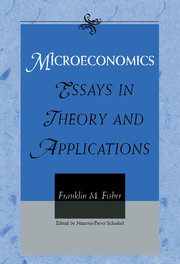Book contents
- Frontmatter
- Contents
- Introduction
- Part I Disequilibrium and Stability
- Part II Welfare Economics and Consumer Theory
- Part III Applications of Microeconomic Theory
- Part IV Industrial Organization, Economics, and the Law
- Part V Public Policy Applications
- 29 Standing Up to Be Counted: The Decision not to Adjust the 1990 Census (1994)
- 30 The Economics of Water Dispute Resolution, Project Evaluation and Management: An Application to the Middle East (1995)
- Epilogue
- Indexes
30 - The Economics of Water Dispute Resolution, Project Evaluation and Management: An Application to the Middle East (1995)
Published online by Cambridge University Press: 20 March 2010
- Frontmatter
- Contents
- Introduction
- Part I Disequilibrium and Stability
- Part II Welfare Economics and Consumer Theory
- Part III Applications of Microeconomic Theory
- Part IV Industrial Organization, Economics, and the Law
- Part V Public Policy Applications
- 29 Standing Up to Be Counted: The Decision not to Adjust the 1990 Census (1994)
- 30 The Economics of Water Dispute Resolution, Project Evaluation and Management: An Application to the Middle East (1995)
- Epilogue
- Indexes
Summary
Introduction
Water disputes among and within countries are common sources of friction. In particular, one of the conditions for the success of the current peace process in the Middle East is the reaching of an agreement over water rights and water allocations. The waters of the Jordan and Yarmouk rivers and those of the mountain aquifer shared between Israel and the Palestinians are all subject to various claims.
This paper reports on an economics-based approach to such issues that may assist their resolution as well as promoting efficient management of the water resources involved.
Ownership and Usage of Water: The General Approach
Water disputes are usually thought of as disputes over the ownership rights to quantities of water. But economic analysis suggests that, however important such rights may be, the question of water ownership rights and the question of water usage are analytically independent and should not be confused. Moreover, analysis of water scarcity rents – of efficiency prices for water in different locations – can assist in resolving disputes over ownership rights by producing estimates of their monetary value. Such analysis also provides a powerful tool for efficient water management, particularly for the evaluation of various projects such as the construction of pipelines, dams, recycling plants or desalination plants.
The Harvard Middle East Water Project – a joint effort of Israeli, Palestinian, Jordanian, and North American scholars – is performing such an analysis for the water systems of Israel, Jordan and the Palestinian entity.
- Type
- Chapter
- Information
- MicroeconomicsEssays in Theory and Applications, pp. 519 - 536Publisher: Cambridge University PressPrint publication year: 1999



